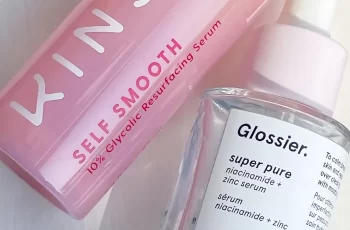
How To Dilute Salicylic Acid Powder?
If, like me, you consider yourself quite “clued up” when it comes to all thing’s skincare, you may be surprised that every now and then there is a product or ingredient around that can make you have a double take. That is exactly what happened to me when I stumbled across salicylic acid powder. I’ll admit, after feeling a little foolish, discovering that you are able to find this potent beta hydroxy acid in powder form makes perfect sense.
So, with that in mind, I wanted to share with you everything I have discovered about salicylic acid powder and what it can do for the skin, so let’s dive in together and find out more.
What is salicylic acid powder?
One of the most used beta hydroxy acids, salicylic acid is often found in a variety of different skincare products. Praised for its abilities to work deep into the pores and unclogs them from excess sebum, dirt, bacteria, and other impurities. With this potent powerhouse also being available as a powder, there are more concerns that can be combatted, from treating warts, calluses, psoriasis, and dandruff.
You’ll be able to find salicylic acid powder is available to purchase, and through prescription both of which are highly potent and must be used as instructed to avoid any flare-ups in skin sensitivity and irritation. If you ever have any concerns, its best to consult with your doctor to discuss the most effective way of introducing salicylic acid powder into your routine.
How do I mix salicylic acid powder?
If you are wanting to mix your own at home salicylic acid solution using the BHA powder, there a few things you need to take into consideration. Here is a guideline on what to do and how to mix your own potent product to help combat blemishes, reduce inflammations, and provide chemical exfoliation.
Step one- Choose a carrier oil for the base of the formula
The carrier oil is the main body of the formula and not only keeps the skin hydrated, it also helps the active ingredients spread across the face and absorb into skin.
Keeping in mind what skin type you have will help you choose a carrier oil that will benefit your skin most of all. Those who are prone to oiliness and blemishes work best with jojoba and grapeseed, those who are drier will reap the rewards from sweet almond oil and avocado.
Step two- Select the best essential oil
This is an additional step you can have as essential oils are best avoided if you suffer from sensitivity. For those of you who aren’t dry or sensitive, adding an essential oil will give your formula an added boost and helping hand in targeting any concerns, tea tree for example is ideal for combating blemish and acne prone skin. Whereas lavender help calm and soothe inflammations and reduces redness. You’ll need about 20 drops of your essential oil to get the optimal results.
Step three- Time to add your salicylic acid powder
The amount of powder you add into your mixture will obviously determine its potency. If you are wanting my advice, I would suggest making your formula mildly potent which ensures if you get a little carried away and apply too much, there won’t be any unwanted side effects. Each salicylic acid powder is different so always check the instructions on the packaging. For an active level of salicylic acid, it is thought that a tablespoon of the powder is the best amount to use. Don’t forget if at any point you are worried about making your solution too potent check with a doctor or trained professional for peace of mind and no nasty side effects.
Step four- Use propylene glycol for dissolving the BHA
Before you add the salicylic acid into your oils, it needs to be dissolved. The best way of doing this is by using propylene glycol which can be found in any pharmacy.
Step five- Finding the best packaging
Once the solution is mixed decant it into an opaque bottle, try your best to keep it upright and for the first few days there may be signs of separation between the ingredients. You just need to give the formula a shake to blend the ingredients together again. Store your product in a cool, dark, place away from direct sunlight and a room that fluctuates with heat.
How do you dissolve salicylic acid powder?
Salicylic acid is notoriously difficult to dissolve. The best way of dissolving salicylic acid powder is with a mixture of alcohol, water, and propylene glycol. If you are finding this difficult to find, it is thought that vegetable oil makes a good substitute for propylene glycol.
How do you use salicylic acid powder at home?
The recipe I have described previously is the ideal way of using salicylic acid powder at home. Ensuring the salicylic acid is of active levels in you at home formulation will help combat impurities and bacteria that are found on the surface of the skin which can often build up and cause a few concerns, from breakouts, such as spots and acne to a dull and lack lustre complexion, not to mention, warts, corns, and calluses.
What is the best way to use salicylic acid?
There are many ways of using salicylic acid in your daily skincare routine. Quite often you’ll find the BHA is formulated into many skincare products, however the most effective are exfoliating toners and overnight serums. Depending on the skin type you have will also mean how often you are able to apply these products, for those prone to being oilier and blemish prone, you can use salicylic acid twice a day. Those who are drier may want to bypass using it and instead opt for a milder acid, such as lactic acid or a member of the PHA family.
DQH Can I use salicylic acid first and then vitamin C?
It’s easy to create a skincare routine, but knowing how to use it is another thing entirely. In most cases, if you’re not getting the desired skin results, it could be due to the layering of conflicting ingredients. So, is it possible that salicylic acid and vitamin C are such ingredients? Or are these active ingredients the duo that’s been missing from your skincare routine? If you want answers, stick around because today we are going to explain the benefits of salicylic acid and vitamin C and how they can be used in your daily life.
What are the benefits of salicylic acid for skin?
Salicylic acid is one of the most commonly used beta hydroxy acids and is favored by many people with oily, acne-prone skin. This acid is derived from willow bark, and unlike its water-soluble relatives (called alpha-hydroxy acids), salicylic acid is oil-soluble, which means it can penetrate deeper into the lower layers of the skin. Once it reaches the lower layers, it can help unclog pores of excess sebum, dirt, bacteria, debris, and impurities. This results in clearer skin tones and greater definition.
Not only does salicylic acid benefit the underlying layers, but the outer surface of the skin benefits as well. When applied to the skin, salicylic acid removes the buildup of dead skin cells. This is accomplished by breaking the bonds that hold dead cells to the surface. Over time, this can cause the complexion to look dull and prone to acne, blackheads, and other blemishes.
If you’d like to learn more about salicylic acid and how it can improve your skin, check out this dedicated blog post from a beauty insider.
What are the benefits of vitamin C for skin?
Vitamin C is considered one of the most powerful antioxidants, which means it is very effective at fighting free radicals and preventing them from causing further skin damage. Examples of free radicals include pollution, central heating, UV rays and harsh climate. They attack proteins, fats and cell membranes as soon as they come into contact with the skin, causing signs of premature aging such as fine lines and wrinkles as well as hyperpigmentation, flaky patches of skin and loss of elasticity.
Many people usually prefer to use vitamin C in their morning routine as this ingredient gives the complexion a radiant glow. You’ll also find that vitamin C can target areas of hyperpigmentation, plumping the skin and reducing the appearance of fine lines and wrinkles.
The thing about vitamin C is that there are a lot of outdated studies going back to the 1950s that describe vitamin C as an unstable skin component. Thanks to improvements in modern technology, this is no longer the case as all products now contain a stable form of vitamin C.
Visit The Beauty Insider to learn more about vitamin C. So please check out our blog post.
Can I use salicylic acid first and then vitamin C?
Yes, you absolutely can. In fact, it’s thought that using salicylic acid before using vitamin C ensures it penetrates faster and works faster.
This is an efficient way to utilize two power sources, and the reason has to do with pH. For example, the skin’s natural pH is about 4.7, making it slightly acidic. Salicylic acid and vitamin C are also both acidic, and you’ll find that vitamin C is absorbed quickly into the skin. Therefore, using salicylic acid beforehand can increase the acidity of the skin and allow vitamin C to penetrate into the skin faster.
While this is considered an effective way to combine two powerful ingredients, you need to be aware of your skin type and how it reacts to certain active ingredients. Even people with perfect, normal skin can experience skin sensitivity and irritation. Therefore, always consult a doctor or dermatologist before using any new products on your skin.
It’s also important to follow skin application rules. In this case, you need to use the product correctly to ensure you get the best results for your skin. If you’re not sure what I mean, the basic rule for skin is to start with the thinnest consistency and work your way up to the thickest consistency. This prevents a barrier from forming on the surface, preventing other active ingredients from penetrating the skin.
Can I use salicylic acid at night and vitamin C in the morning?
Yes, absolutely, this is considered the most effective way to get returns without any adverse side effects. This is because there is enough time between applications to ensure that the skin’s pH levels return to balance.
You’ll also find that Vitamin C is rich in antioxidants and is perfect for use in the morning to ensure your skin is protected and looking its healthiest. Due to the small size of salicylic acid molecules, it is an acid that is able to reach the deepest parts of the skin. While this is effective at keeping skin clear, it also increases the risk of irritation and photosensitivity. Therefore, many people prefer to use powerful BHAs in their evening routine without exposure to UV rays, pollution, or harsh weather.
Warning: If you avoid using sunscreen every day, none of these ingredients will do what your skin needs. The combination of chemical peels and powerful ingredients increases the risk of further damage to the skin’s surface. Use SPF 50 every day to keep your skin protected and your lipid barrier healthy, even on cloudy days, keeping your skin in top condition.


